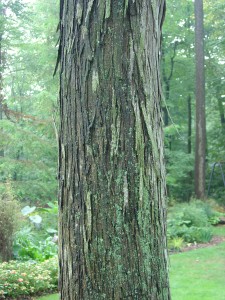Most tree lovers don’t plant U.S native shagbark hickory (Carya ovata) (USDA hardiness zones 4-8). Instead, they often inherit one when purchasing property. Shagbark hickory is notoriously difficult to transplant and grows very slowly in its early years. Like oaks (Quercus spp.) and beeches (Fagus spp.), hickories are long-lived, often standing tall in an open woodland setting for 200 years or more. Success with growing hickory is to not disturb its roots.
Shagbark hickory is a large tree, reaching 60-80 feet in height, but is capable of growing over 100 feet. Hickory grows naturally in moist well-drained river bottom soils although it is not uncommon to find hickory growing in a dry upland site.
Summer foliage is medium green and coarse textured. Leaves are alternate, pinnately compound, 8-14 inches long with usually 5 leaflets, sometimes 7. Each leaflet is 4-6 inches long and 1 – 2 ½ inches wide. Leaves stay mostly blemish-free until minor leaf spot diseases arise in late summer. Hickory is susceptible to a number of environmental stresses, including drought and hickory bark beetles. Over a 3-4 week period leaves color from bright gold to bronze before abscising in late autumn.
Male and female catkin flowers appear on the same tree in mid-spring and get little notice. Hickory nuts are a delicious food resource for humans as well as woodland inhabitants, including several bird species. The thin shelled round nuts are 1 – 1 ½ inches in diameter. Among nut lovers trees with sweet kernels and quality are tagged.
The grayish brown bark separates into thin curved plates, creating an overall “shaggy” appearance, hence the name “Shagbark Hickory.” Over the years large amounts of bark, leaf and nut debris may accumulate lots of litter. Hickory’s beauty far outweighs a little extra raking.
Hickory is a large shade tree suited for large properties, parks and golf courses. Winter gray shaggy bark and golden fall color are its major assets.


 Posted in
Posted in 
